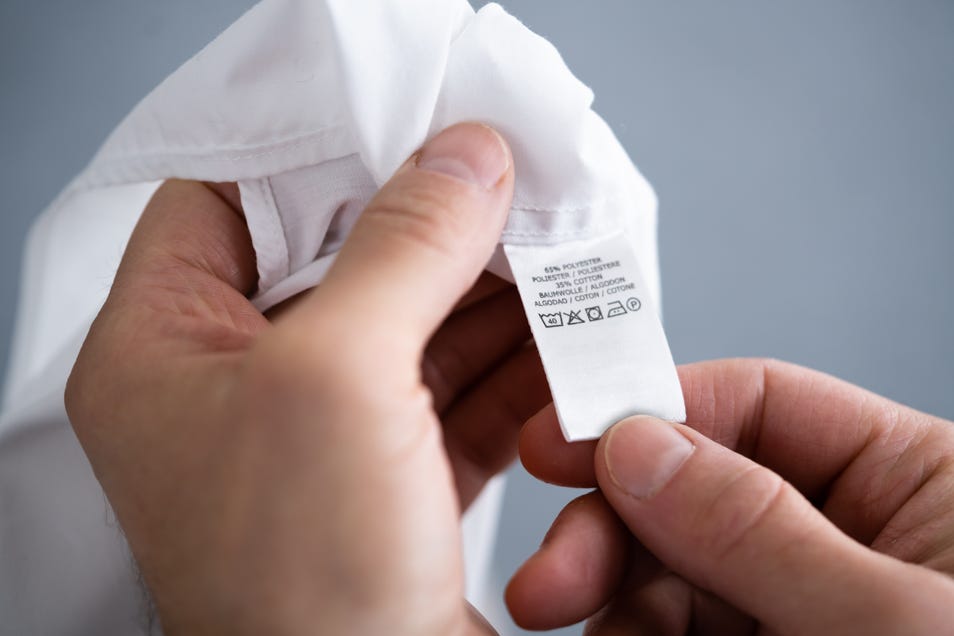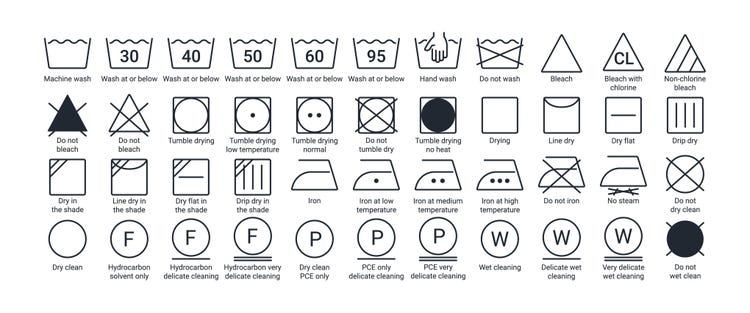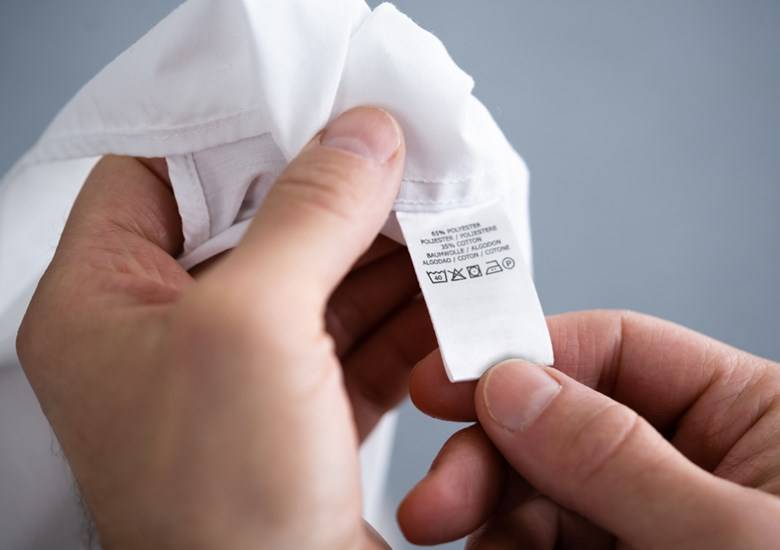Wash it Right! Washing Symbols on Clothes Explained for Perfect Laundry Care
Understand laundry icons, washing tips, and fabric care methods. Decode washing labels and learn how to treat stains safely and effectively at home.

Understanding clothes washing symbols on garment tags is the first step toward making your clothes last longer and look better with every wash.
Laundry can feel confusing, especially with all the icons on clothing labels, but these symbols are key to preventing shrinking, colour bleeding, and fabric damage.
In this guide, you'll get clothes washing symbols explained in simple terms. Understand laundry symbols better to clean effectively, protect fabrics, and make your wardrobe last longer.
Why Clothes Washing Symbols Matter
According to a UK-based survey reported by The Jerusalem Post, 53% of people admitted to having washed clothes multiple times to get them clean, and the same number have ruined garments due to incorrect laundry habits.
Ignoring laundry labels can damage your clothes and your wallet. Taking a few moments to understand and get these laundry icons explained correctly can significantly extend the lifespan of your clothes and help you avoid unnecessary damage.

Understanding Laundry Icons: Your Laundry Tag Decoder
Clothing care labels use standardised icons that indicate how to wash, bleach, dry, and iron each item. Let's break them down:
Washing Symbol: The Bucket
This icon tells you how to wash the item and at what temperature.
• A number inside the bucket shows the maximum temperature (e.g., 30°C or 40°C) — always keep it under 40°C to avoid shrinkage.
• A hand symbol = hand wash only.
• A crossed-out bucket = do not wash; usually dry clean only.
Bleaching Symbols: The Triangle
This symbol indicates whether bleach can be used and which type is safe.
• Plain triangle = bleach safe.
• Triangle with two lines = use only oxygen-based bleach (not chlorine).
• Crossed triangle = avoid bleach completely.
Drying Symbols: The Square
Drying instructions help avoid shrinkage and fabric damage.
• A square with a circle = tumble dry.
• Dots = heat setting (1 dot = low heat, 2 = medium, 3 = high).
• Lines inside a square = line dry or flat dry.
Ironing Symbol: The Iron
This tells you how hot your iron should be — or if you should skip it entirely.
• Dots show the heat level suitable for ironing.
• Crossed iron = do not iron.
Dry Cleaning Symbol: The Circle
Used for items that require professional cleaning.
• A plain circle means dry-clean friendly.
• A cross = no dry cleaning.
• Letters indicate the solvent type used by professionals.
Smart Laundry Techniques: Pre-treat, Soak, or Wash
Using the right method makes stain removal more efficient and safer for fabrics. The best laundry results often come down to three steps, but remember, these steps are mutually exclusive.
You either pre-treat and wash or soak and wash. No need to combine all three at once.
Pre-treating (for Tough, Visible Stains)
Ideal for treating concentrated stains before washing.
• Mix a small amount of stain remover powder with water to form a paste.
• Apply gently using a soft laundry brush (not your hands).
• Let it sit for no more than 10 minutes.
• Wash as usual.
Look for ingredients like enzymes that break down food and protein stains (especially effective in powder form). These are especially helpful when dealing with stubborn marks commonly missed if you do not understand clothes washing symbols correctly.
Soaking (For Set-In or Widespread Stains)
This method is best for multiple or older stains spread across the garment.
• Add 1 scoop of stain remover to 5 litres of warm water.
• Soak for up to 6 hours for whites or 1 hour for coloured garments.
• Rinse thoroughly and then wash.
Check for active ingredients such as sodium percarbonate (oxygen bleach), optical brighteners (for whites), and TAED (helps activate cleaning even in cold water).
Washing (For Everyday Stains)
Use this step to clean lightly soiled garments or after treating stains.
• Add ½ scoop or a capful of stain-removing powder or liquid along with detergent.
• For tougher stains, increase the dose slightly.
• Wash as per garment label guidelines.
Surfactants, both anionic and non-ionic, help remove greasy stains and improve water penetration for a deeper clean.
Ingredients to Look for in a Good Stain Remover
The right formulation can dramatically improve washing results — not all stain removers are created equal, so check the company's label for these ingredients to ensure an effective and fabric-safe cleaning:
- Enzymes (in powders): Break down food, sweat, and dirt stains
- Sodium Percarbonate: Releases active oxygen for deep cleaning
- TAED: Helps oxygen bleach work better at low temperatures
- Optical Brighteners: Make whites look brighter
- Surfactants: Lift grease and help rinse away dirt
- Dye Transfer Inhibitors: Prevent colour bleeding during the wash
- Carboxymethyl Cellulose: Keeps dirt suspended, so it doesn't resettle on clothes
All of these contribute to the desired results, especially when used alongside the correct techniques and with a clear explanation of laundry symbols in mind.
Laundry Care Tips to Remember
These small tips can make a big difference in results.
- Always test stain removers on a small, hidden part of the fabric.
- Avoid using bleach on garments with metal zippers or buttons.
- Never rub stain removers directly with your hands – use a soft laundry brush.
- Do not soak or pre-treat clothes made of wool, silk, or delicate baby fabrics.
- After treatment, avoid drying clothes in direct sunlight until they've been rinsed.

Wash Smarter, Not Harder
With the right know-how and a little attention to detail, laundry becomes effortless. By putting into practice everything covered in this guide, with clothes washing symbols explained in clear, simple terms, you'll be able to follow care labels confidently and avoid common laundry mishaps.
Using the correct techniques, along with a proper understanding of clothes washing symbols explained through universal icons, ensures you're not just removing stains — you're protecting your garments with every wash.
Sources
ISO 3758:2023 – Textiles — Care labelling code using symbols
GINETEX – Textile Care Symbols
NHS Scotland – Washing Clothes at Home Information Leaflet
Oxford Health NHS – Advice on Washing Patients' Clothes at Home
More clothing tips
- Whether it’s for everyday wear or special garments, Vanish makes it easy to maintain the colours you love.
Sweat, Rinse, Repeat: How to Wash Workout Clothes Properly
Learn how to wash workout clothes, remove sweat odours, and maintain fabric quality. Keep your gym wear fresh and long-lasting.
![how to wash workout clothes]()
![Decode washing machine symbols and laundry signs with our ultimate guide]()

